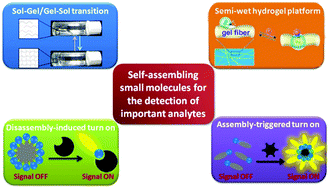Self-assembling small molecules for the detection of important analytes
Abstract
Nano-materials formed by the self-assembly of small molecules are very promising for drug delivery, regenerative medicine, and detection of important analytes due to their unique properties, such as self-assembled multivalency, biocompatibility, and fast response to external stimuli. This tutorial review focuses on their applications in detection of important analytes. Self-assembling small molecules can show fast response to external stimuli. Therefore, the gel–sol/sol–gel phase transitions of supramolecular hydrogels that can be easily identified by naked eyes have been applied for the detection of enzymes and enzyme-involving analytes. The supramolecular hydrogels can also provide semi-wet environments that can retain the activity of enzymes and recognition properties of molecular probes. Thus, they provide good platforms for the detection of many biologically and environmentally important analytes. Besides, self-assembling small molecules show big differences in fluorescence or the F-NMR signal between their self-assembled and un-assembled stages. Such small molecules can be rationally designed through the integration of fluorescent dyes or fluorine containing molecules in the self-assembling small molecules. Therefore, extensive recent research efforts have been made to explore their detection applications based on the dis-assembly triggered fluorescence/F-NMR signal turn on or the self-assembly/aggregation induced fluorescence turn on. We believe that the research efforts made to this field will ultimately lead to the development of useful nano-materials for detection applications.


 Please wait while we load your content...
Please wait while we load your content...